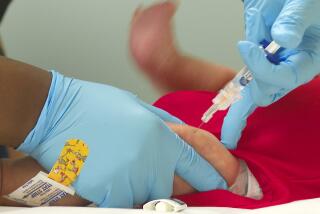Fewer Children Receive Vaccines for Common Diseases
- Share via
WASHINGTON — Cases of measles, mumps and whooping cough have risen steadily over the last several years while the percentage of young children receiving vaccines has dropped, according to a recent report by the Children’s Defense Fund.
Public health officials have become worried that if the trend continues, childhood diseases that are now considered minor problems in the United States could return in force.
“Anytime you have a disease that can be prevented by a vaccine, the effort of the nation should be to eliminate it,” said Surgeon General C. Everett Koop. “Compare the cost of the vaccine--in pain as well as money--to the cost of the disease. We need to reach the children we are missing.”
Health experts say that diminished federal funds have been responsible for at least part of the problem. As funds have been cut during the last five years, it has become increasingly difficult for poorer children to gain access to vaccines, according to the report.
1990 Objective
The surgeon general has set as a health objective for 1990 that at least 90% of the nation’s children have vaccines before they are 2 years old. But general levels of immunization for preschool children worsened between 1980 and 1985, according to federal statistics.
Progress toward the surgeon general’s vaccination goals slowed or fell off for most major childhood diseases in the past five years, the Children’s Defense Fund report says. For polio, measles, rubella, mumps and DPT (diphtheria, pertussis and tetanus), the percentage of children under two who received full immunization declined between 1980 and 1985.
During those years, the last for which there are complete statistics, the proportion of one- to four-year-olds receiving no doses of polio vaccine rose by 40% for children of all races and 80% for nonwhite children, according to the report. In addition, cases of mumps rose in 1986 after a 15-year decline, and in 1985 there were 3,589 reported cases of whooping cough, or pertussis, the highest number since 1970.
“This is becoming a very serious problem,” said Dr. Richard Narkewicz, president of the American Academy of Pediatrics. “The immunization program in this country is a bulwark for the future health of our children. It has been built over years and it is beginning to erode.”
Narkewicz cited several reasons for the drop in the percentage of children seeking immunization. The liability risks have driven the costs of vaccines up and pushed many drug companies out of the business. Also, because vaccines pose an inherent--but incredibly small--risk to children under two, some parents decide to avoid them.
“Many American pediatricians have never even seen whooping cough,” Narkewicz said. “Because the disease is so rare a certain complacency begins to settle in. But as long as the disease is still out there, it cannot be ignored.”
Parental Fears
Many health officials believe that parental fears about bad reactions to vaccines have been blown out of proportion. Nearly 11 million children are immunized in America each year and about 30 to 50--at most one out of 220,000--have reactions that cause permanent damage.
The development of successful vaccines for most major childhood diseases has been regarded as a hallmark of modern medicine. Vaccines routinely protect children against seven diseases: polio, measles, mumps, rubella, diphtheria, tetanus and pertussis.
More to Read
Sign up for Essential California
The most important California stories and recommendations in your inbox every morning.
You may occasionally receive promotional content from the Los Angeles Times.










